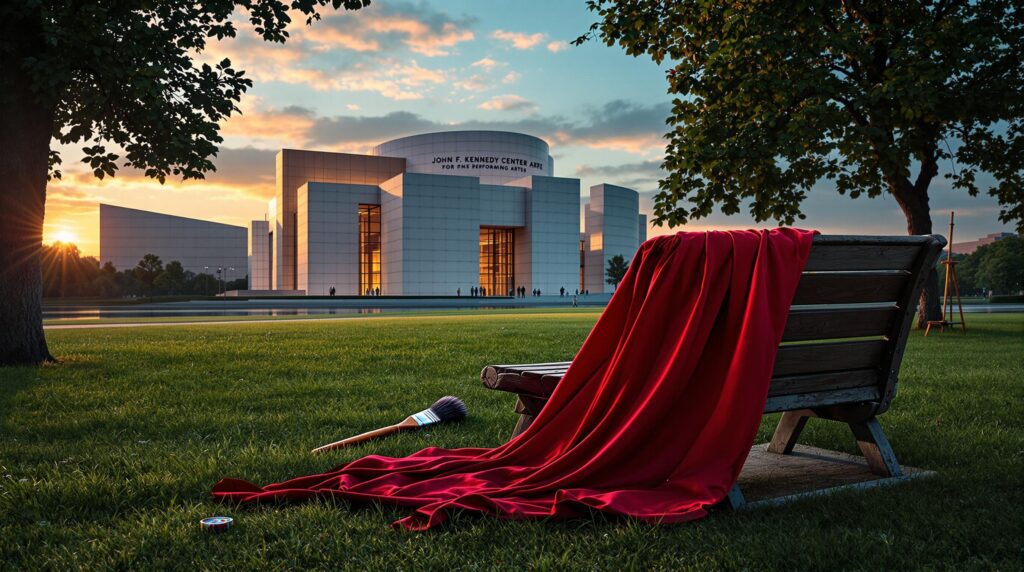Bold Stand or Reprehensible Act?
The Kennedy Center recently found itself embroiled in controversy following the bold actions of Tavish Forsyth, a 32-year-old contract worker at the institution’s Opera Institute. Forsyth, who identifies as queer, took a dramatic stand by releasing a provocative 35-minute video protesting President Donald Trump’s influence over the historically diverse and inclusive organization. In the video, which quickly stirred heated discussions, Forsyth stripped naked to emphasize the vulnerability inherent in censorship and marginalization.
At the heart of Forsyth’s protest was a passionate denunciation of Trump’s policies and his perceived takeover of the Kennedy Center. Trump had recently made headlines by appointing allies to significant roles within the institution, a move that worried many who pride the Center on its heritage of support for diverse and avant-garde art forms, including drag. Forsyth’s symbolic act underscored the tension between traditional conservative governance and progressive cultural expression.
Conservative Takeover or Cultural Decline?
The explicit nature of Forsyth’s video attracted swift condemnation from the Kennedy Center’s administration, labeling it as “extremely disturbing” and incompatible with the organization’s values. Roma Daravi, Vice President of Public Relations at the Kennedy Center, sharply criticized Forsyth in public comments, stressing her concerns about the protection of minors involved at the Opera Institute. Daravi suggested Forsyth might have unduly influenced young individuals with “radical ideology,” asserting firmly, “Who knows what kind of radical ideology they have been pushing on the youth? Not anymore. They’re fired.”
However, to reduce Forsyth’s protest to mere sensationalism or inappropriate behavior misses the larger conversation: what does this controversy reflect about the state of artistic and political expression in America right now? Forsyth’s criticism of Trump’s administration wasn’t merely focused on employment conditions but encompassed a broader discontent with conservative pushes to reshape American cultural institutions.
“The revolution is now,” Forsyth proclaimed, stark in activism yet reflective of genuine anxieties many Americans feel about the direction under conservative leadership.
Historical context helps to understand the gravity of this situation. The Kennedy Center has long symbolized an American commitment to cultural diversity and freedom of artistic expression. Any form of censorship or ideological control imposed upon its programming doesn’t align with the institution’s celebrated history nor its reputation as a beacon of American ideals. Whether or not one agrees with Forsyth’s method, their outright rejection by the Kennedy Center echoes anxieties over the erosion of these freedoms.
Artistic Freedom at Stake
Forsyth’s internal struggle over their professional association with the Kennedy Center, articulated clearly in the film, illustrates a poignant internal debate. They questioned whether continuing their affiliation with the institution constituted complicity with administration-aligned censorship, asking if staying would make them “a collaborator or somehow complicit in a hostile government takeover.” Forsyth’s explicit critique challenges us to consider how artists, particularly those involved in institutions receiving federal support, can balance personal principle against professional stability.
The passionate heart of Forsyth’s message was clear: conservative interference and governance under Trump’s allies threatens the livelihood and liberties of marginalized communities often championed through artistic expression. In Forsyth’s eyes, Trump’s involvement signified a rollback on freedoms gained through years of progressive struggle, impacting poor and marginalized communities, people of color, LGBTQ+ communities, immigrants, and women.
The reaction and subsequent firing of Forsyth leave liberal and progressive groups pondering the precarious position of cultural institutions in today’s politically polarized climate. This provocative protest poses a complex question: Can influential arts institutions like the Kennedy Center resist political pressures when reliant on governmental favor?
While Forsyth’s actions might have been controversial, their underlying concerns reflect broader fears about censorship, artistic suppression, and rising intolerance. Ultimately, Forsyth’s protest, despite its explicit nature, challenges conservatives’ attempts to dictate American culture’s moral and artistic boundaries.
The Kennedy Center’s reaction has ignited dialogue far beyond Forsyth’s singular act of protest, sparking crucial discussions about freedom of expression, progressive rights, and the contested future of American institutions. For progressives and artists alike, the specific response from the establishment—immediate dismissal and distancing—indicates troubling concessions to conservative pressures rather than tailored, nuanced solutions to difficult questions of artistic freedom and professional integrity.
As America continues grappling with the ideological battles that spill into our cultural landscape, Forsyth’s naked defiance, however provocative, carries a significant message: vigilance and courage may be necessary for preserving the vibrancy, diversity, and inclusive spirit defining American arts and culture.

